

In a blender, process the tomatoes and water until completely smooth. In a pot add the olive oil, onion strips and salt. Saute for 2–3 minutes. Add the chicken cutlets and sear on one side till golden brown, flip and repeat on the other side. Add the processed tomatoes and cook over medium heat till the chicken is done. Drain the chickpeas and wash them. Add them to the chicken pot, cook over medium heat for 7–10 minutes.
In another pot, add the maftoul pearls, olive oil, chickpeas, allspice, cumin, and salt. Add 4 cups of the chicken tomato broth. Cook on low heat, covered for 5–7 minutes. Turn off the heat, Allow it to stand for 10 minutes, then fluff with a fork.
To serve, place the maftoul pearls in your serving dish. Top with shredded chicken or whole chicken cutlets. Add some chickpeas and a ladleful of broth. Serve with more tomato broth on the side.
Recipe courtesy of PARC

Recipe courtesy of PARC.
above: Gary Goodman with his father.
Is your dad a coffee lover, a brewing geek, or the kind of guy who takes his daily dose of caffeine like medicine? No matter what his blend, you can help him get the best out of his morning ritual this Father’s Day. It’s a way to say: “Thanks for being there for me, over the years!” We’re excited to share our line of single-origin coffees and our manual brewing tips, below.
On a day that celebrates relationships, the most meaningful gift can be time spent in appreciation. If your father’s around, that might mean a slow cup of coffee with him and a heart-to-heart. Or maybe you’ll just take a moment to acknowledge the role-model — dad, stepdad, relative or friend — who helped shape you.
As Father’s Day comes around each year, it reminds me of something I learned from early on; family, the one you’re born into and the one you build, is one of the most important parts of life.
Family has a huge impact on the opportunities afforded to you, the degree of love and security you feel while growing up, and is a great source of joy and sorrow. On Father’s Day, I remember the incredible impact my dad had on me. He taught me how to work, how to play and how to love. He taught me to put family first, and that as you build a family of your own, that sometimes you need to make personal sacrifices to keep the family strong. The memories that are most vivid for me are the times I spent with my father one-on-one. When he asked me about my life, provided gentle guidance and fatherly wisdom. It is in these moments, these memories, that the true essence of what Father’s Day is materializes for me.
As I have grown older, and become a father myself, I have gained new insight into fatherhood and a new understanding of my own father. When I think about what I want out of Father’s Day, it isn’t a new tie, a case of beer or some other material object. What I want to give, and to receive, is time. Time to talk, to connect, and to make memories with the ones I love and who love me. So as you ponder what to do for Father’s Day this year, remember what truly matters; a chance to remember those special moments with your dad, and if you’re lucky, to make some new memories in the year ahead.
Let’s face it. Everyone’s dad is unique — and so are our single-origin coffee beans. Each has its own particular aroma, flavor and aftertaste. Explore the full selection and find the perfect brew for your dad.
Looking to spice up the morning coffee ritual, and put a little extra hair on his chest? If he isn’t already into manual brewing, Father’s Day could be the perfect opportunity to introduce a new way to brew. Read and watch Equal Exchange Coffee Quality Coordinator Mike Mowry’s tips for brewing the perfect cup in his comprehensive, step-by-step guide.

Traducido por Mercedes Paloma Lopez Mancillas, de la Oficina Regionál del Suroeste de CRS en San Antonio, Texas y por Scarlett de la Vega Ochoa, Oké Banana (Equal Exchange’s fairly traded bananas), West Bridgewater, Massachusetts.
(Read the English-language version here.)
Pollo en Mole Poblano es un platillo tradicional Mexicano con pollo cocido en una salsa oscura, picante, y con una base de chocolate. Esta primavera, los empleados de Equal Exchange y nuestros aliados de Catholic Relief Services, preparamos tres cazuelas de mole – cada una ligeramente distinta – con ingredientes orgánicos y de comercio justo. El veredicto fue unánimo: ¡qué rico!
Amamos cocinar casi tanto como amamos compartir relatos. Debajo, lea más sobre nuestros distintos trayectos con el mole. Luego, ¡intente este auténtico platillo Mexicano en su propia cocina!
Nos unimos, Sandy Davis, Kate Chess, y Peter Buck, trabajadores-propietarios de EE; para hacer mole en la cocina de la sede de Equal Exchange, en Massachusetts. Utilizamos Chocolate Amargo Extremo, Almentras Naturales, y Aceite de Olivo Palestino. Usamos como referencia el muy usado libro de Peter, The Complete Book of Mexican Cooking por Elisabeth Lambert Ortiz, y adaptamos generosamente la deliciosa receta de 50 años para que cumpliera con nuestras necesidades.
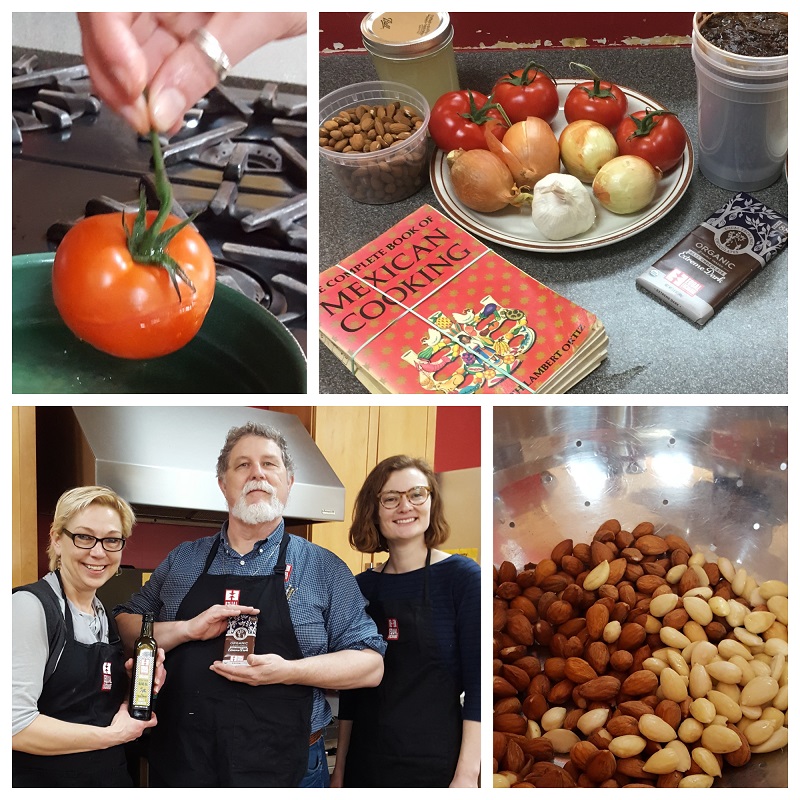
Primero, cortar dos pollos grandes en porciones individuales. Cubrir con agua y llevar a ebullición. Hervir a fuego lento por una hora, luego drenar y secar. Guardar dos tazas del caldo de pollo. Calentar tres cucharadas de Aceite de Olivo Extra Virgen Orgánico en una sartén para freír. Dorar el pollo en el aceite y pasar las piezas a una cacerola grande u horno holandés.
Después, preparar y combinar los ingredientes para la salsa. Empezar con 14 chiles secos: (6 ancho, 4 pasilla, 4 mulato – o si no están disponibles, usar sólo ancho). Remover los tallos y semillas de los chiles, romper en piezas y transferir a un tazón grande. Hervir suficiente agua para cubrir los chiles. Echar el agua caliente sobre los chiles y remojar por una hora.
Mientras se remojan, picar dos cebollas medianas y cuatro dientes de ajo. Pelar, desgranar, y picar una libra (medio kilo) de jitomates. Blanquear y pelar una taza de Almendras Naturales Orgánicas. Combinar la cebolla, ajo, jitomate y almendras con media taza de Pasas Flame Orgánicas Equal Exchange (disponibles a granel en muchas tiendas de alimentos naturales), media cucharadita de clavo molido, canela molida, y semilla de cilantro molida; media cucharadita de anís, y dos cucharadas de ajonjolí. Agregar dos o tres ramas de cilantro fresco y tortilla de maíz en trozos. Utilizar una licuadora eléctrica para moler todos los ingredientes hasta que quede como un puré espeso.
Ahora, cocinar el puré. Recalentar el aceite en la sartén. Saltear el puré en el aceite caliente por cinco minutos, moviéndolo constantemente. Agregar las dos tazas de caldo de pollo que se reservaron al hervir el pollo, y una onza y media (14 gramos) de Chocolate Amargo Extremo Orgánico (88% cacao). Mezclar hasta que el chocolate se derrita. El puré debe estar más denso que la crema espesa.
Finalmente, vaciar la salsa sobre el pollo en el horno holandés y cocer cubierto, a fuego muy bajo, por 30 minutos. Espolvorear con dos cucharadas de ajonjolí y servir con tortillas, arroz, y frijoles.
¡Buen provecho!
¡Nos divertimos mucho haciendo este platillo y recomendamos como un ejercicio de vinculación, la colaboración en esta complicada receta y sus varios ingredientes! Pero, ¿qué tal quedó? Nuestra compañera de trabajo, Scarlett de la Vega Ochoa dijo, “¡Este mole está bueno – y eso que soy de Puebla!”
Sergio López es un Gerente de Relaciones con sede en San Diego, California, en la Oficina Regional del Oeste de CRS. Intentó una sabrosa receta de mole que encontró en Internet. Sergio utilizó Almendras Naturales Orgánicas de Equal Exchange y nuestro Cocoa Horneado Orgánico, versátil y de alta calidad.
Aquí está su historia:
Si bien mi esposa y yo crecimos en hogares mexicanos, no siempre nos enseñaron cómo cocinar la sorprendente comida reconfortante de nuestra infancia. Parte de nuestro camino como “adultos” ha sido reclamar las partes deliciosas de nuestro crecimiento para que algún día podamos pasárselas a nuestros hijos y nietos.
Con este espíritu, recientemente decidimos darle un toque de comercio justo a la receta tradicional del mole. Fue la primera vez que cualquiera de nosotros hizo la salsa de mole desde cero y me alegra decir que ¡no decepcionó! Una mitad de pollo cubierto con una salsa de seis tipos diferentes de chiles, verduras asadas, Almendras de Equal Exchange y Cocoa Horneado de Equal Exchange servido con una cama de arroz hecha para un plato delicioso y ético que estaremos ansiosos por compartir con la familia y amigos en los próximos años.
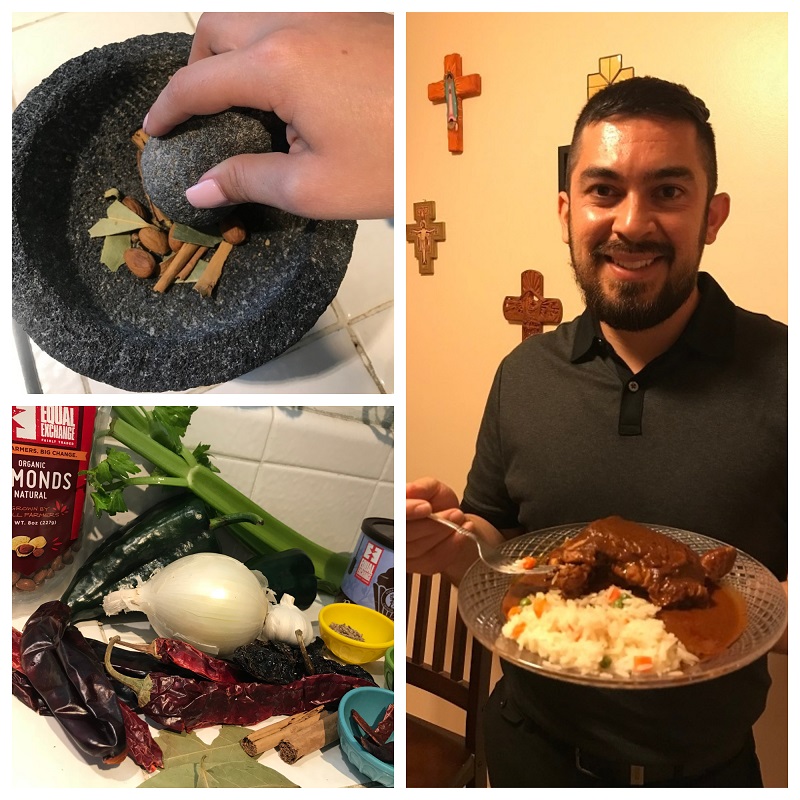
Aquí está la receta que utilizó Sergio:
Norma Valdez es Gerente de Relaciones en la Oficina Regional del Suroeste de CRS en San Antonio, Texas. Probó la receta secreta familiar de su tía abuela, una herencia de cinco generaciones. Al igual que Sergio, Norma también utilizo Cocoa Horneado Orgánico y Almendras Naturales Orgánicas de Equal Exchange – gran diferencia de los cacahuetes (mani) que exige la receta. Norma tiene instrucciones estrictas de no compartir su receta. ¡Es un secreto!
Pero ella compartió la historia:
Mi Tía Bessie fue querida por todos, muy de familia y amaba cocinar; nunca podrías ir a su casa sin comer. Aprendió esta receta mientras vivía con su bisabuela en Puebla, México.
Tía preparaba este mole para todas las ocasiones especiales, como bodas, bautizos, quinceañeras, eventos relacionados con la iglesia, al igual que lo hizo su bisabuela. La cantidad más pequeña que haría serían seis pollos enteros. Más tarde, cuando ella y mi Tío se jubilaron, comenzaron a hacer su mole para otras personas, pero cobraban. Protegía celosamente su receta porque había otra señora en el vecindario que también preparaba mole para ocasiones especiales y cobraba.
Ella no le enseñaba a cualquiera como prepararlo. De hecho, no conozco a ningún miembro de la familia a quien ella le haya enseñado excepto a mí. Pero cuando vio que realmente me encantaba cocinar, e incluso tomé clases y cociné para ella, realmente quería que aprendiera a cocinar su mole.
Ella me dijo que cuando ella aprendio, era un evento de todo un día, porque tenían que preparar a las gallinas, es decir, matarlas y limpiarlas. A ella nunca le gustó esa parte, pero vivieron en una granja y en aquel entonces no había carnicerias como los que tenemos hoy.
Nunca antes había utilizado almendras- la receta de Tía exige cacahuetes (maní) – pero salió bien. No tan bueno como el de mi Tía Bessie, pero estuvo bien, incluso mi sobrino y mi sobrina que solo comen el mole de Tía Bessie estuvieron de acuerdo. El cacao también fue favorable en la receta. Utilice menos, porque era una buena calidad de cacao.
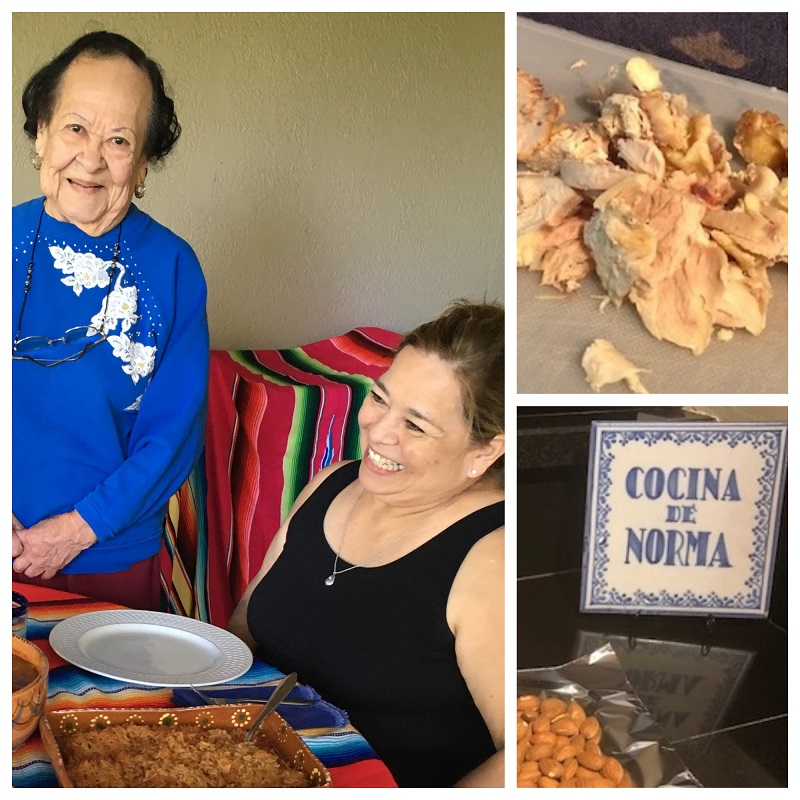
¿Tienes una receta de mole favorita? ¿Alguna vez has intentado cocinar un plato especial con ingredientes de origen ético? ¡Cuéntanos en los comentarios!
By Danielle Robidoux, Action Forum Organizer
As consumers, as people, we are pretty disconnected from most of our products. We may believe a label brings us closer to the real story, but at the end of the day, labels don’t tell stories, people do.
Last week, on an Action Forum webinar with Pushpika Freitas of Marketplace: Handwork of India, I was pretty floored. I felt proud to have her as an ally in this work and was moved, not only by how she told the story of Marketplace, but by how she truly honored the stories of the women she worked with. Marketplace is a nonprofit Alternative Trade and Development Organization that grew out of a small-scale venture in 1980 to help three low-income women in Mumbai, India. Today, Marketplace has grown into a flourishing ATO working with 400 artisans that are organized into 11 independent cooperatives. Marketplace seeks to provide opportunities for women to participate in all aspects of running the cooperatives while producing high-quality women’s apparel and home decor.
Photo credit MarketPlace: Handwork of India
From the work Pushpika has done with Marketplace she shared with us two important lessons that resonated with me. The first lesson she shared was that we are outsiders. While we may have read countless articles, traveled on delegations abroad, had conversations entering the wee hours of the morning, these are not our stories. We are on the outside of them. No one can truly encapsulate all of the complexities of someone’s story, except them. Real stories are gritty, they include details that would probably make most people uncomfortable. As conscious consumers, as activists, as people, do we want the label or do we want the real story?
As alternative traders we have never claimed to be perfect. We mess up, we make mistakes, but we are learning. We are sharing with you, our story.
The second lesson Pushpika learned pretty early on was how important it was to listen, and that the direction of Marketplace would come from the women she worked with. She was able to adapt her business based on the needs of the women, they were at the center.
Photo credit MarketPlace: Handwork of India
Pushpika shared a story with us from the early days of Marketplace, as they were gaining success, she wanted to go beyond providing employment. She was brainstorming what could be beneficial, and suggested a nutrition program. She was quickly met with laughter, in part because the women knew she couldn’t cook. The women then identified their needs, which were not as expected. They wanted to learn how to sign their names, and to learn numbers 1-20. The women would need to sign permission slips for their children with a thumbprint if they could not sign their names, they found this humiliating. Similarly, when asked on the street about the numbers of the bus routes, they wanted to have an answer.
Pushpika Freitas pictured above, Founder and President of MarketPlace: Handwork of India.
By engaging in deep listening we can increase our understanding, we can help to facilitate change that is actually needed. By listening we can connect ourselves to real stories that bring about real change.
If you would like to stay connected to monthly webinars, deeper conversations, and in-person events discussing some of the issues that plague our food system click here to join the Equal Exchange Action Forum.
The above photo is from a social media campaign by Marketplace in which women were asked what they were thankful for.
By Dee Walls, Food Safety Coordinator
Each January, against my own better judgement, I sit down and write out my resolutions for the coming year. I reflect on the previous 365 days, and resolve to be better and to do better. Often times, these aspirations involve food, so I research and plan how I might alter my methods of food consumption to effect positive change in my life. Food, which has become as much of a technical object as a cultural one, is an incredibly important part of our lives. In deciding how we nourish ourselves, we make decisions that are simultaneously nutritional and environmental, political and economic.
As time passes in January, and my motivation begins to falter, I begin the other annual tradition of abandoning those things which I was so passionately committed to achieving a few weeks earlier. This usually coincides with a long weekend, culminating with a holiday in remembrance of Dr. Martin Luther King, Jr. As I lay there snacking guiltily, scrolling through my timelines on various social media platforms, I am comforted by all of the quotes describing dreams, justice, and nonviolent resistance. For a moment, I consider that perhaps this year will be different.
In an essay titled “The Dangerous Road Before Martin Luther King,” James Baldwin describes two opportunities he had to meet King. During the first encounter, Baldwin attends a service at King’s church in Montgomery, Alabama. The King that Baldwin aligns with the narrative of King that we have grown so familiar with: humble, kind, and inspiring.
Baldwin and King next cross paths in Atlanta, Georgia, three years after the first encounter. King faced many personal struggles during those three years, including legal battles in Alabama and Georgia, and an attack that left him severely injured. Baldwin depicts a much different King during this meeting, a more tormented one, yet one still retaining the aforementioned compassion and resolve. Moreover, Baldwin recounts the development of the student movements of the American civil rights era. He writes that, “It is the sons and daughters of the beleaguered bourgeoisie […] who have begun a revolution in the consciousness of this country which will inexorably destroy nearly all that we now think of as concrete and indisputable.”
Opposite this nascent revolution was the existing “publicized Negro leadership,” with goals described by Baldwin as “nothing less than the total integration of Negroes in all levels of the national life.” King was affiliated with this incumbent leadership, towards which the younger revolutionaries directed criticism, bitterness, disappointment, and skepticism. Baldwin sympathizes with the older leadership, acknowledging that, “It was not easy to wring concessions from the people at the bargaining table, who had, after all, no intention of giving their power away.” Nevertheless, Baldwin discusses a “dullness” among this older leadership, “the result of its failure to examine what is really happening in the Negro world—its failure indeed, for that matter, to seize upon what is happening in the world at large.”
It is this precarious position, caught between exciting change and an increasingly impotent status quo, that King finds himself in, and the inspiration for the title of the essay. Baldwin writes that, “King has had an extraordinary effect in the Negro world, and therefore in the nation, and is now in the center of an extremely complex crossfire.” Similar to King, I believe Equal Exchange now finds itself in a similar position as we continue to seek new ways to effectively execute our mission.
Equal Exchange began in the spirit of leadership committed to the meaningful consideration and involvement of small farmers in all levels of global society through fairer trade practices. Indeed, King was “hideously struck” by the effects of this exclusion, having traveled to India in 1957 and witnessing tremendous poverty that he described to Baldwin “in great detail.” In the 30 years that Equal Exchange has been in existence, the food system has continued to evolve in ways that perpetuate the marginalization of small farmers in the Global South.
Today, we are surrounded by food products that boast of “quality,” “safety,” and “sustainability.” These are incredibly important attributes to seek out, but we have grown accustomed to simply looking for a seal or certification associating these terms with the products we consume, and in the process their meanings have started to grow “dull.” This dullness, I believe, is similarly related to their inability to accurately reflect to consumers what it takes to produce goods that truly embody these characteristics.
It is easy to solely emphasize the myriad examples of what our food system does not currently get right. I do, however, feel that we are in the midst of exciting cultural transformation. Closing his essay, Baldwin leaves us with the following:
“For everything is changing, from our notion of politics to our notion of ourselves, and we are certain, as we begin history’s strangest metamorphosis, to undergo the torment of being forced to surrender far more than we ever realized we had accepted.”
Change can be daunting, but it is not something we have to endure in isolation. Equal Exchange’s business model boldly demonstrates the possibility of more collective and cooperative forms of engagement within our societal institutions. In a food industry rife with opportunity for transformation, we must resist the urge or tendency to let our work and our message grow dull.
As I scroll through my social media feeds this year, things feel different. In between quotes from King I see articles from Black Lives Matter and The Movement for Black Lives. I see collections of photos from friends and family commemorating the one year anniversary of the Women’s March, as well as the courage to declare #MeToo and “Time’s Up”. I double tap events held by members of my community organizing for immigration and prison reform. I experience chills at the fact that in the same place where King, as Baldwin describes, “found himself accused, before all the world, of having used and betrayed the people of Montgomery,” we now celebrate a demonstration of what is possible in the era of Trump when informed, empowered individuals show up and participate in the democratic process.
How we eat matters. The recalcitrance of old, bigoted norms and values can be surmounted. We do not have to stand idly by in the midst of a system producing calorically dense, nutritionally poor products via a network of ever-consolidating firms. It is possible to create a food system where we are not just defined as workers and consumers separated from producers. We can create alternative institutions that involve more ownership, citizenship, and partnership with one another in ways that are not rooted in subjugation and exploitation. The assassination of King in 1968 demonstrates just how perilous the work of striving for justice can be, but his legacy lives on and we continue to draw upon it for inspiration each January.
I am convinced that this year can be different, and I encourage you to join Equal Exchange in exploring the ways in which we can become more meaningfully committed to doing this work. Take a moment to explore more of the information about Equal Exchange available on our website. Read through some information about our producer partners, join the Action Forum community, or browse the webstore for a gift for someone who may be unfamiliar with our organization. Together, we can resolve to continue striving to create food products that are truly safe, of high quality, and produced in ways that are socially and ecologically sustainable all throughout the supply chain.
Last month, we traveled to the West Bank to visit our Palestinian suppliers of organic extra virgin olive oil. At Equal Exchange, we are more than familiar with the daunting challenges and obstacles confronting cooperatives of small farmers growing coffee, cacao, and many other products. To those, we need to add all the constraints of physical movement and access to water that are everyday realities for Palestinian farmers given the Israeli occupation of the West Bank. As we met with farmers, technicians, leaders and students, and toured facilities over the several days of our visit, we were thoroughly impressed by the scope of initiatives managed by our counterpart, the Palestinian Agricultural Relief Committee (PARC).
What follows is a sharing of what we learned during our October visit, first some observations on the general climate in which Palestinians (especially farmers) live, then a bit more on PARC and the compelling projects they are carrying out.
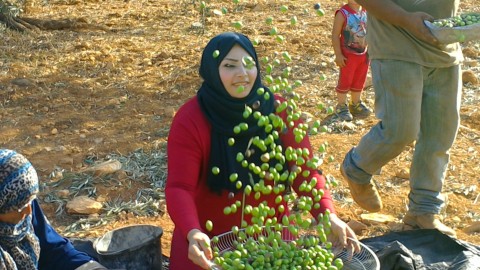
The odds are stacked against Palestinian farmers. They work land that is dry as a bone and is getting more arid due to climate change. Sixty five percent of Palestinians in the West Bank live in rural areas. Many families in those areas own olive trees but the groves are relatively small and generally contribute to only a portion of a family’s income. Though trees are able to produce olives with very little water, other crops such as wheat, almonds, and dates are limited due the severe water shortage limits imposed by the climate and by the Israeli government.
The water supply for the West Bank is only available through water mains a few times a week on an unpredictable schedule. There are restrictions enforced by the Israelis on how much rainfall can be collected. Reusing and treating waste water is restricted, as is digging wells. There is also a discrepancy in the amount of daily water usage depending upon who you are. There are currently about 2.6 million Palestinians living in the West Bank and about 700,000 Jewish settlers living there. If you are Palestinian, your allotment of water is 75 liters per person per day; if you are an Israeli Jew, living in a settlement, your allotment is 300-350 liters of water per day (over four times as much). Settlers are allowed to consume more water and pay less money for it. Without water and land you can’t talk about development in the West Bank. If agricultural projects could expand with increased water, PARC estimates that it could help provide 200,000 more jobs for Palestinians.
The construction of the barrier wall separating the West Bank and Israel which began in 2003 has created countless obstacles for olive farmers. Not only did the wall itself annex large swaths of the West Bank, it also separated many farmers from their groves. Limited access times at the wall, compounded by the numerous checkpoints throughout the West Bank, prevents farmers from being able to employ the kind of agricultural practices that would maximize yields—and incomes. In addition, every year there are attacks by settlers on farmers during the harvest.
Finally, it’s impossible for Palestinian trucks to gain direct access to seaports or airports. So they must unload their trucks to be loaded by Israeli trucks at the checkpoints on the other side of the barrier. This business has become so expensive and cumbersome that the number of Palestinian trucks carrying produce and other goods destined for export has dropped from 25,000 to 10,000. There are also very few refrigerated trucks and storage facilities for perishable crops. Very concretely for Equal Exchange, these increased costs make Palestinian olive oil far less competitively priced than we would like, meaning we can’t sell as much of their oil as we would very much like to do.
PARC’s primary mission is to provide hope for Palestinians in the West Bank and Gaza: economic sustainability and independence for people who are displaced and severely restricted. The NGO has been dedicated to working with Palestinian farmers since the 1980s and predates the Palestinian Authority’s Ministry of Agriculture, which was established after the Oslo Accords in 1993. PARC works with 40 agricultural cooperatives made of 20-80 members. Building on relationships we established in our first trip in 2011, we came back from this recent visit with even more respect for PARC’s vision and its tangible approaches to creating economic opportunities for so many. Here are PARC projects that we visited in the West Bank.
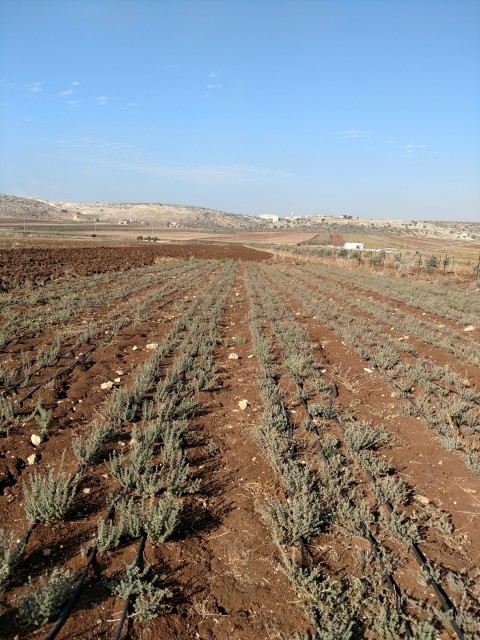
We visited a modern olive oil press at the Mazare’ Al Noubani cooperative near Salfeet. There are 86 members of the co-op who use the press, plus four other groups that pay a fee for its use during harvest season, which lasts 6-8 weeks. During this period the press is open 24 hours a day to receive sacks of olives from farmers’ trucks.
PARC was able to secure a bank loan to purchase the Italian machinery used at the press on terms. It will gradually pay off the loans when it receives fees from farmers after the harvest; then it will finish constructing the building. Funds for the press building came from Oxfam, the Palestinian Farmers Union, the French Palestinian Solidarity Association, and the Swiss Agency for Development and Cooperation.
We viewed the process from beginning to end. Olives are ideally pressed for oil within an hour of being harvested. The olives get a quick wash and branches and leaves are removed. Heated water is added to make the olive mash easier to crush, but the press temperature can’t be higher than 81 degrees Fahrenheit. Then the oil, water and pits must be separated out. A good olive tree produces about 16-20 liters of oil.
It’s an energy efficient system as well. The pumice (from the olive pits) is used to fuel the boiler and to heat the water. The olive oil is pumped into stainless steel holding tanks at the press. Finally, it is labeled and sent to PARC’s bottling station at its headquarters in Ramallah. Equal Exchange purchases about 25,000 bottles of extra virgin olive oil each season from PARC.
We learned about the “We Are With You” campaign, in which volunteers serve as witnesses to offer Palestinian farmers protection while they harvest their olives near the wall. PARC has helped to organize these volunteers for the past 15 years. They come from a range of countries, such as Australia, France and Canada, and stay in farmers’ houses for 1-2 weeks at their own expense.
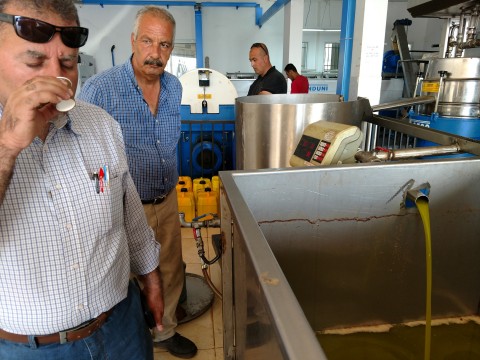
We met Nabeel Munmod Abu Ara, the head of the Aqqaba Almond Cooperative in Jenin. The co-op has 87 members, 57 of whom grow almonds, an initiative that began 10 years ago. Three out of the nine members of the Administrative Commission and 19 members of the co-op are women.
Almond trees were introduced by PARC as a part of a pilot land reclamation project. Now there are more than 200 hectares of trees. To prepare the land, the farmers had to remove rocks from the soil, built retaining walls, compost, and added other organic soil supplements. As the farmers started investing in their trees, they saw that it was a feasible business. In Jenin, unemployment is 15 percent below the national average (versus 27 percent overall in the West Bank and 44 percent in Gaza) partly due to the Arab-American University of Jenin, its student body of 12,000 students, and the resulting higher level of education in the area.
There is, however, a serious shortage of rainfall in the area, and farmers need supplemental irrigation for the trees. December through March is the rainy season. However, this past year the last day of rain was February 20. Nabeel experimented with irrigation in March and July and the productivity of the trees more than doubled the output. He had to purchase the additional water, increasing costs considerably.
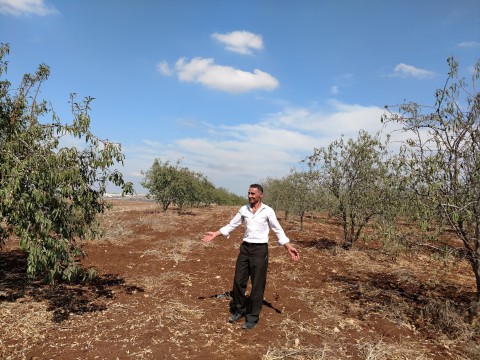
The Holy Land Cooperative in Zababdeh near Jenin is comprised of 28 men and eight women. PARC supported them on their transition to organic; and once they had initial crops, PARC helped them with marketing. The co-op has constructed a fish farm in a greenhouse; and the pond water is piped through the rest of the greenhouse and used as fertilizer for grapes, strawberries, and pineapples. This achieves four times more growth than plants grown in the ground; no water is wasted.
PARC has helped the cooperative to cultivate varieties of fruits and vegetables, such as cabbage and melons that are high in productivity quality. The cooperative also grows and dries thyme, which is an ingredient of the Middle Eastern spice blend called Za’atar, together with sesame seeds and sumac. They sell their organic produce and spices at the local market for better prices.
The Machtas Couscous Cooperative in Jericho started with a $2,500 loan from Al Reef, PARC’s commercial and export arm. The building was given to them by PARC., and PARC’s staff trained the women to make couscous. It was a way to create jobs and to continue making a staple that is part of the Palestinian heritage. In the beginning there were 15 members, and today there are 30 members, from age 20 to 70. The co-op is structured as an open meeting with all members allowed to contribute to discussions and to help making decisions. Three women are elected to serve as the governance committee.
The women use a special black wheat that is produced in Jenin in two co-ops. Members order the quantity of wheat they need and run the operation. The women mix whole wheat flour and water by hand sitting on the ground in the traditional way, using a series of strainers. The wheat clusters are then steamed in an oven at 100 degrees for 25 minutes; afterwards they are dried. The process is like semi-cooking and gives the grain a shelf life of two years.
The co-op negotiates costs, prices and quantities. Income is tied to productivity, and members determine their own schedules, which can be very flexible. Most work from 7 a.m. to 12 noon. Then they return to their homes for family and social life. The work is virtually year round with December through February generally being down time. With Jericho serving as a key center for a lot of PARC / Al Reef production activity, the women are able to earn additional income in several other capacities including making the Za’atar spice mix and fumigating and shelling almonds. In September and October they work at the date-filling station. Co-op members rely upon PARC technicians for quality control, while promotion and markets are handled by Al Reef.
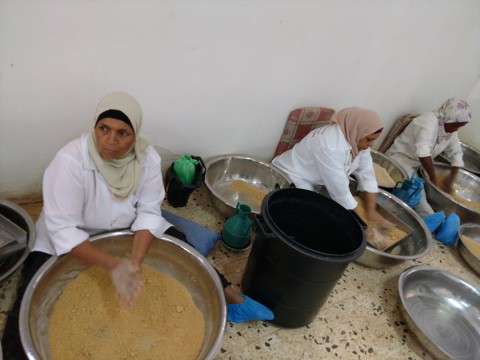
Before the 1993 Oslo Agreement, farmers in the West Bank were not allowed to grow Medjoul dates, due to unwanted competition with Israeli growers. When this law changed many farmers started growing Medjoul dates. This is an important crop for West Bank farmers since date palms can grow with some salination in the water—a phenomenon resulting from Israeli settlement pulling vast amounts of fresh water from the natural springs in Jericho. Palestinians on the West Bank are legally allowed to retrieve partially salinated well water (which is beneath the fresh water in wells). Dates are a crop that can bring in added income with scarce resources. In 1996-97, PARC purchased Medjoul date palms for $100 each and sold them to Palestinians for $20. In 2001, they produced just a few hundred pounds of dates. By 2009, the amount had increased to thousands and they needed a more modern filling station to wash, dry, sort and pack the dates. They have a beautiful new plant with sophisticated and more computerized systems.
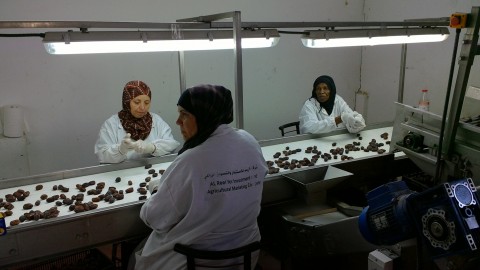
Dates are another crop like olives with a short harvest season: mid-September to the end of October. The dates are received and sent to be dried and fumigated for 72 hours. They are sorted by weight and by the quality of their skin. The plant also makes date paste and date molasses. The line sorters are the women from the couscous cooperative who work shifts during the date harvesting season.
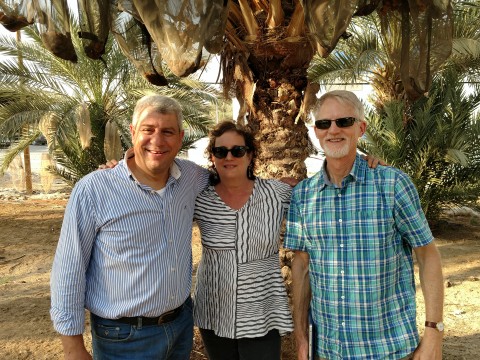
PARC has two agronomist training centers for college graduates who spend a year practicum in agriculture (PA), which is completely subsidized by PARC. When the PA began in 1995, PARC wanted to train fresh agronomists after they graduated from four or five-year programs from the university. They created ways to provide hands-on training for them through the centers. The government of Luxemborg supported this effort and built the academy in Jericho three years ago.
Over the last 20 years they have expanded their focus to dates, eggs and dairy products. Every year 40-50 students graduate. Half spend their time in Jericho, the other half are in Zabedi. Students get practice on animal farms, plant farms, and factories for agricultural projects. The agronomists choose a focus among different aspects of farming, such as soil or water. There are lectures in classes and two hours a day working on a site.
The PARC Agricultural Academies have graduated a total of 1,600 students. Eighty percent of the people who work in the PA’s Agricultural Ministry come from these centers. In fact, the current director graduated in 1997 from the center’s first class.
While part of the mission is to promote organic farming, what stood out most powerfully for us was the confidence that these young women and men gain from both the educational and social aspects of their year in training. With an overriding mission to build hope for the future among the Palestinians, PARC is, with good reason, deeply proud of this success.

Sugar.
It seems like such a simple thing. The essential ingredient we so often buy in the U.S. that ends up in something delicious that makes us happy – a morning cup of coffee, a celebratory cake, or a pan of brownies.
The reality is, sugar is far from simple. We could dedicate a lot of space to the disconnect between small-scale farmers and the market due to the control of export by large sugar mills that have all the power at source. Or, we could highlight the continued labor abuses on sugarcane plantations as graphically detailed 10 years ago in the documentary, “The Price of Sugar,” which depicts the plight of Haitians who have been lured into a form of indentured servitude on sugar plantations across the border in the Dominican Republic.
We aim to cover some of this in future blog posts, but today we want to look at something that we see so blatantly on a yearly basis when we work to import sugar from small-scale farmers into the U.S.: the manner in which corporate sugar barons have manipulated trade policy to disproportionately benefit themselves at the expense of smaller producers, including thousands of peasant farmers around the world. U.S. shoppers who might be inclined to support small-scale farmers have little choice and pay far more than they should due to a complicated system of price supports and duties. So let’s dig in a bit more.
The U.S. sugar industry has long used money and political clout to protect and grow the industry, as exemplified by the discovery last year that the sugar industry paid scientists in the 1960s to place the blame for heart disease on saturated fats instead of sugar, influencing decades of U.S. health policy.
Today, the sugar industry focuses money and resources on political lobbying to prop up domestic sugar prices and control sugar imports from cheaper sources. In large part due to the outsized donations and influence from the sugar industry, the U.S. Department of Agriculture enacts a complicated sugar policy with price supports and quota systems that elevate U.S. sugar prices above world market prices – sometimes two-to-three times higher than the world market price.
On the surface, this policy appears sweet and maybe it’s not so bad for our health if sugar is not dirt cheap. Supporting U.S. production keeps cash, investments, and resources domestic, and Equal Exchange is are all for that when it helps local economies and local communities. Digging a little deeper, however, the effects may have a bitter outcome.
These protected American producers are not necessarily small-scale operations and often the benefits land in the hands of a few who have disproportionately high influence over the industry. And, American consumers end up paying higher prices for sugar and sugar-containing products at the grocery store.
Current policies can be traced back to a relatively small number of key actors. Arguably, the most significant actors are the Fanjuls. The Fanjul family co-owns the world’s largest sugar refinery here in the United States and are significant names behind big companies like Florida Crystals and Domino. In the 1980s, the Fanjul sugar barons outgrew Florida and expanded production to the Dominican Republic. Today their Dominican company, Central Romana, is the largest private landowner and employer in the D.R. This company has been fined numerous times for labor law violations and mistreatment of their workers, many of whom are Haitian and Jamaican immigrants.
To protect their interests, the Fanjuls are major donors to lobbying groups and political candidates. Conveniently, their political ties are bipartisan: one brother is a Democrat and the other is a Republican. Before the 2016 presidential election, they hosted benefit dinners for candidates Hilary Clinton and Donald Trump. Historically, the Fanjuls have even hosted presidents at their 7,000-acre Casa de Campo resort in the D.R. Some of the policies they influenced include federal health recommendations of sugar consumption, higher volume trade quotas with the Dominican Republic, and lowering environmental regulations in the Everglades. According to one environmental lawyer in a 2016 issue of The New Yorker, “Given the choice between buying a tractor and hiring a lobbyist, the sugar industry is going to hire a lobbyist every time.” Because of the Fanjuls’ dominant presence, other sugarcane growers in the United States and around the world struggle to compete.
These trade policies impact organic and small-scale farmers in a big way. Equal Exchange’s producer partner for sugar, Manduvira co-op in Paraguay, emerged as an alternative to conventional sugarcane plantations, supporting over 1,000 small-scale producers to grow organic sugarcane. Like its neighbor Brazil, Paraguay also suffers from deforestation in its Atlantic rainforest due to rising agricultural pressures. Unlike its neighbor Brazil, Paraguay has a higher proportion of its population living in rural areas (40 percent of rural residents in Paraguay compared to 14 percent in Brazil). This results in a higher proportion of Paraguayans who are still dependent on agriculture, such as sugarcane, as their main source of income and subsistence.
Sugarcane in Paraguay has become yet another industry that denies access to the small producer. Major sugar refineries in Paraguay own their fields and only purchase from outside producers after all their company sugarcane is processed, and only if there is a high enough demand – often long after the small farmer’s ideal harvest cycle.
In 1995, members of Manduvira worked together to establish Fair Trade certification for sugarcane and sell their product cooperatively. They have been so successful that today, Manduvira built and manages its own mill for its own sugarcane production, making it the first and only organic sugar mill owned by small-scale farmers! Their accomplishment serves as an example, not only for Paraguay, but also for the international cooperative community, and is one way to combat global sugar giants. Equal Exchange is committed to our partnership with Manduvira, and we work diligently within the context of biased policies and costly tariffs to import their sugar.
For the small-scale farmers that have put their heart and soul into Manduvira, to access the U.S. market Equal Exchange has to work with Manduvira to navigate the U.S. sugar quota system. Organic sugar is considered a specialty sugar and there are five specialty sugar windows in which it can be imported each year.
Manduvira’s sugar needs to arrive at a U.S. port, in this case it’s New York, during a sugar window so it can be cleared. To get it to New York on time, it needs to get on a river barge from Asuncion, the capital of Paraguay, to make its way to the ocean where it will be loaded on an ocean vessel bound for New York from Montevideo, Uruguay, or Buenos Aires, Argentina. This trip can take 40-60 days depending on how smoothly all the pieces line up, so to have the sugar land during the sugar window is often a bit of a miracle given all the external factors.
If the product arrives on time, Manduvira sugar is then competing with many other companies trying to access the window and there is a limited amount of sugar allowed with each window. After all of that effort, the sugar may end up entering the U.S. at a high duty rate or only a percentage of the shipment will access the low duty rate if the quota is prorated amongst all the people accessing the window. When this sugar doesn’t get in at a low duty rate, which has certainly happened, it is pretty much impossible for Manduvira’s sugar to compete and be viable in the U.S. market.
While getting a little in the weeds on the importing side of business, this demonstrates the real systemic challenges small-scale sugar farmers face, whether that’s in Paraguay or the United States. Power is concentrated in the hands of those with big money, keeping those who are marginalized by the system voiceless and poor. Despite the unlevel playing field, we are inspired by the members of Manduvira co-op and hope to see more stories like theirs.
Written by Dary Goodrich & Laura Bechard, Chocolate Team
Thank you for signing up for our newsletter!
What does democracy mean to you? Do you believe that you are an active citizen in a democracy? How about in your food system?
To me, democracy goes beyond showing up for one day to vote for a presidential candidate, sharing a politically charged status on social media, or filling out your e-mail to sign another online petition. Democracy takes effort, commitment, collective responsibility, and passion. It’s not always easy, certainly not simple, but if we as a people are committed to a better world, it cannot begin and end on Election Day.
Danielle Robidoux, left, at an Action Forum event in Boston.
Likewise, participating in the food system cannot begin and end with a purchase. To get closer to a more transparent, just, and safe food system, we need to be fully engaged, not passive consumers. For a long time the jargon of conscious consumerism has been “vote with your dollar.” It is not enough. Now more than ever is the time to not only raise your dollar but to put your voice behind it.
So, how can we become real participants in a democratic food system and make a positive impact to build the world, and the food system, that we want to see? I believe we need to build communities and meaningful connections; there is power in organization, in solidarity, and in numbers. A successful democratic food system cannot be built without an active populace, without active citizen-consumers.
Equal Exchange has always had people at its center. Coffee, chocolate, tea, mango, cashews—these are just mediums by which Equal Exchange can show the world that ethical supply chains are viable—that there is more than one way to do business. The radicalism lies within the Equal Exchange model: a supply chain that is characteristic of true democracy, cooperative learning, transparency, a respect for our planet and its people.
For the past 31 years Equal Exchange has worked on supporting our producer partners abroad and standing alongside them in their struggles, on a journey to build a more sustainable system. We have done this with a commitment to our internal democracy, too, as a worker co-op. As we reflect on the change we have built and the complexities that now define our world, we realized there is a missing piece: you. And so we launched the Action Forum late last year to provide an organizing mechanism.
On June 9, over 100 individuals got together to have a conversation, when Equal Exchange hosted our first-ever People’s Food System Summit. This event brought together all parts of our supply chain: Equal Exchange worker-owners, producer partners, and Action Forum members. The gathering was a milestone for our work to build the Action Forum and to have conversations around food justice. As a community we began to grapple with many food industry dilemmas and how we could imagine building a better food system, together.
The first day of the summit we delved deeply into the corporate consolidation that characterizes our food system, successes and failures of the Fair Trade movement, climate change from the perspective of our producer partners, and alternative buying models that opt out of the corporate system. The second day was spent building the foundation of our community and culture of democracy among members of the Action Forum. We debated and voted on proposals regarding the Action Forum’s path forward, broke out into small groups to discuss how we can build tools and grow our community, and made a commitment to stay connected to continue this work, together.
Our current economic and political climate is not conducive for alternative food systems. The food industry encourages us to think as individual shoppers rather than as a collective. The key to building effective, long-lasting change is to build strong communities centered around people. The Equal Exchange Action Forum is striving to facilitate this work, through connection, democracy, transparency, authenticity, and putting people over profit.
Join us, and add your voice. Learn more here.
I started at Equal Exchange almost two years ago, as a sales rep in Philadelphia. The path that led me here to our co-op was not the most intentional. I went on a series of brutal interviews for a personal assistant job to try to get my foot in the door somewhere in the environmental and community building fields. I spent a year going through interviews, and felt the humanless nature of the whole process; I was a number or name on a piece of paper. I applied to Equal Exchange with little knowledge of Fair Trade and the cooperative movement, but was attracted to a line in the mission statement to work toward a “more equitable, democratic and sustainable world.”
Upon being hired I was warmly welcomed into a community that valued learning, autonomy and risk taking in order to learn. I quickly felt valued as a member of a bigger collective with a shared vision. I felt supported and encouraged. Not only did Equal Exchange value me as a worker and member, but my voice was heard and thoughts valued. During my time spent working in Equal Exchange’s sales department, I had a supervisor that consistently encouraged me to find spaces where I could nurture my skills and passions. The opportunity to work more closely with Equal Exchange’s mission came along through the Organizer position last year and I decided to go for it. With no community organizing experience, I had a team that was again willing to give me a shot.
The Equal Exchange Action Forum is a space within Equal Exchange for individuals to join a virtual and physical community to network, learn and challenge the injustices within our food system. It’s a vehicle to build an authentic and democratic community, and a tool to foster connections and relationships that will connect us to each other and our food. As an Organizer for the Action Forum I see myself as a dot connector to help facilitate building an even bigger community with our customers and allies. Despite the system’s power to commodify every aspect of our lives, including our abilities to connect with one another, here we have the opportunity to create something anew. That element is what truly inspires me to get up and do this work every day. Equal Exchange to me has always been about creating community and fostering connections to people.
Frankie Pondolph, center, with Equal Exchange Co-President Rob Everts, left, and Co-Organizer Danielle Robidoux at an Action Forum event in Jamaica Plain, MA. Photo by Alexander Novakovic, The Daily Free Press.
Today, our growing Action Forum community has around 400 members spanning three different time zones. Our membership is diverse in age, background and passions; each person has a different relationship to Equal Exchange or connection to the work we have been putting forth for 30 years. This, to me, is one of the most fascinating parts about creating the Action Forum: the space to build something organically together. It really is about showing up, having conversations with one another and slowly building something that gives everyone a seat at the table to create the future we’d like to see.
This June we are hosting the first-ever gathering of this growing community, bringing together Equal Exchange worker-owners, our farmer partners and Action Forum members for two days of planning, learning and sharing together. The People’s Food System Summit will include sessions on climate change and its affect on our producer partners, the corporatization of our food system, and alternative food distribution models. The second day is carved out specifically for planning with members on how we may mobilize around an action in the upcoming year.
In many ways this work feels like returning to our roots, 31 years in. The Action Forum creates a space to allow the humanness and relationship building to continue to be a part of what makes Equal Exchange so unique and special. A space where we can take risks, learn, and innovate together. To do this we need to hear your stories, your challenges and your vision.
I hope we can continue to grow the Action Forum community and to continue to use Equal Exchange as a vehicle to propel systematic change – for a more equitable, democratic and sustainable world.
“I salute the present generation. Hang on to one of your most precious parts of youth, laughter – don’t lose it as many of you have seem to have done, you need it. Together we may find some of what we are looking for – laughter, beauty, love and the chance to create.”
— Saul Alinsky, community organizer
If you’re interested in joining the Action Forum or attending the People’s Food System Summit on June 9-10, 2017, fill out an application here or send an email to eeactionforum@equalexchange.coop
Watch the video below to get the tips, or scroll down for a full explanation!
Here are the brewing mistakes we’ve identified — and advice that will help you do better!
Mistake #1: Don’t store coffee in the fridge or freezer! When you store coffee in the fridge or freezer, the grounds can absorb moisture and odors from that space, which will negatively affect the taste of your coffee. Instead, store coffee in a cool, dry place in an airtight container.
Mistake #2: Don’t over- or under-heat your water! Sometimes your coffee will taste off just because it was brewed with water that was too hot, or not hot enough. The ideal temperature is between 195F and 205F. Unfortunately, many home brewers just aren’t strong enough to heat water to the proper temperature for a good cup of coffee, so it’s worth investing in a high quality machine if that’s your preferred method.
Mistake #3: Don’t use a blade grinder or spice grinder! If you’re grinding your beans at home, use a burr grinder. Blade and spice grinders will chop your beans unevenly, leading to a poor extraction that will make your coffee taste off. A burr grinder crushes your beans in a way that gives you a uniform grind, an even extraction, and a better cup.
Mistake #4: Don’t use a dirty grinder! Stale grounds and oils can build up in your grinder and affect the taste of your fresh beans, so it’s important your grinder clean. You can use a commercial product, or grind a scoop of uncooked white rice to clean out old grounds and absorb oils.
Mistake #5: Don’t use the wrong grind for your brew method! Using the wrong grind size for your brewer can lead to weak or bitter coffee, so make sure you know and use the proper grind for your method. Coarse-grind coffee (French press) should resemble kosher or sea salt in texture, medium-grind coffee (drip brewer) should be similar to granulated sugar and fine-grind coffee (home espresso maker) should resemble confectioner’s sugar.
Mistake #6: Don’t use a dirty brewer! Minerals and scale can build up in your brewer, negatively affect the taste of your coffee, so make sure to keep it clean. You can use a commercial cleaning product, or run a cycle of 50/50 white vinegar and water mixture through your brewer to clean it out. Just make sure to run a cycle of plain water through the brewer after that, before you start brewing coffee again.
Mistake #7: Don’t use bad-tasting, unfiltered or distilled water! When it comes to the taste of coffee, the water you use plays a huge role. If you wouldn’t enjoy drinking it from the tap, don’t brew coffee with it. We recommend brewing with filtered tap or bottled water.
Mistake #8: Don’t use an inconsistent or unmeasured amount of coffee! Using too much or too little coffee can drastically affect the taste of your cup, so it’s important to properly measure your grounds. We recommend a 17:1 water-to-coffee ratio, but you can also weigh your coffee according to the specifications of your brew method. From there, you can adjust to taste: if your coffee tastes too strong or bitter, use less coffee, and if it tastes weak or grassy, use more coffee.
Keep these tips in mind to make the most out of your fairly traded coffee whenever you brew at home!
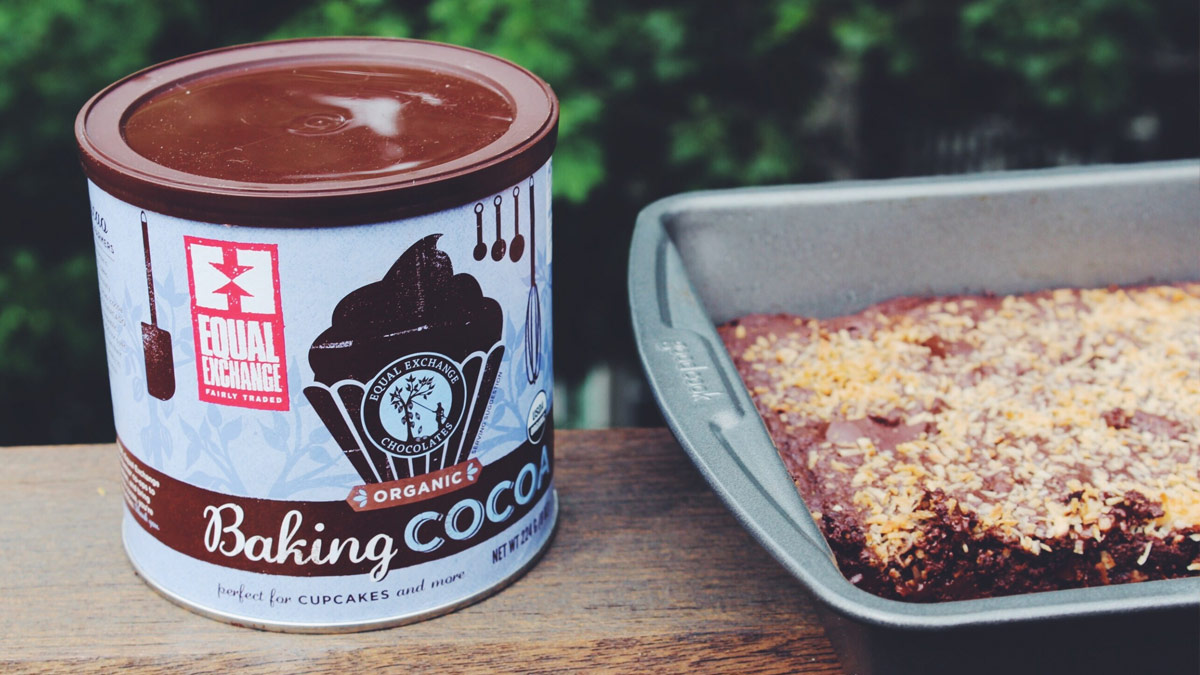
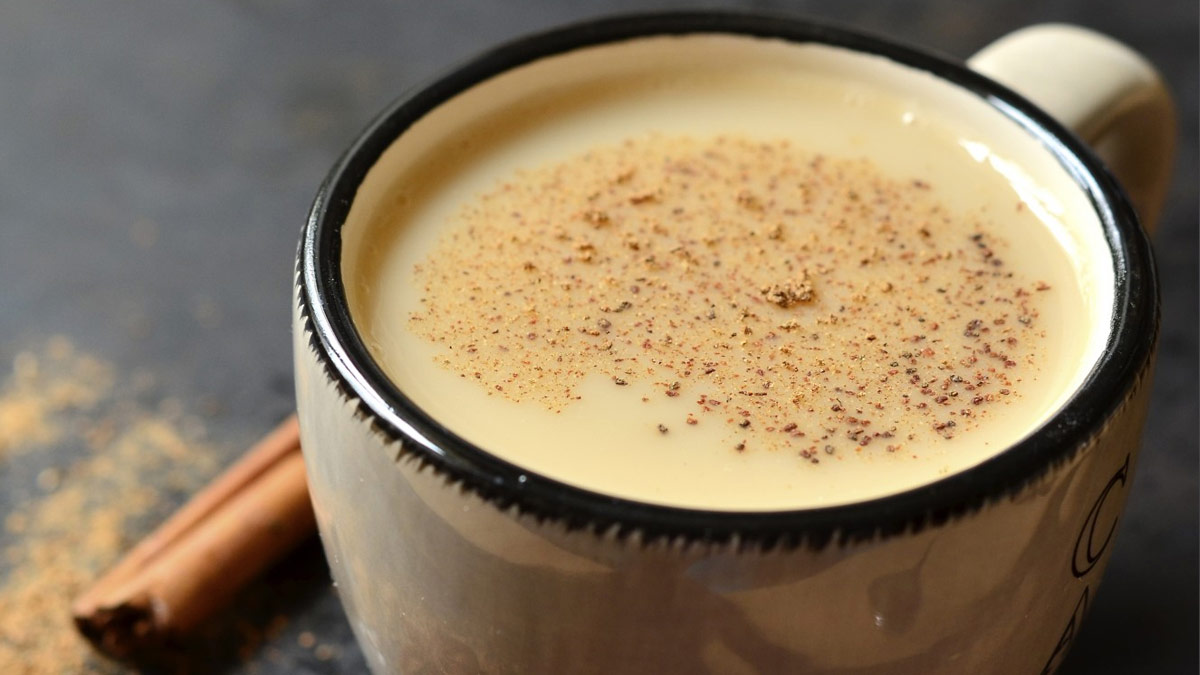
Adapted from Taste of Home
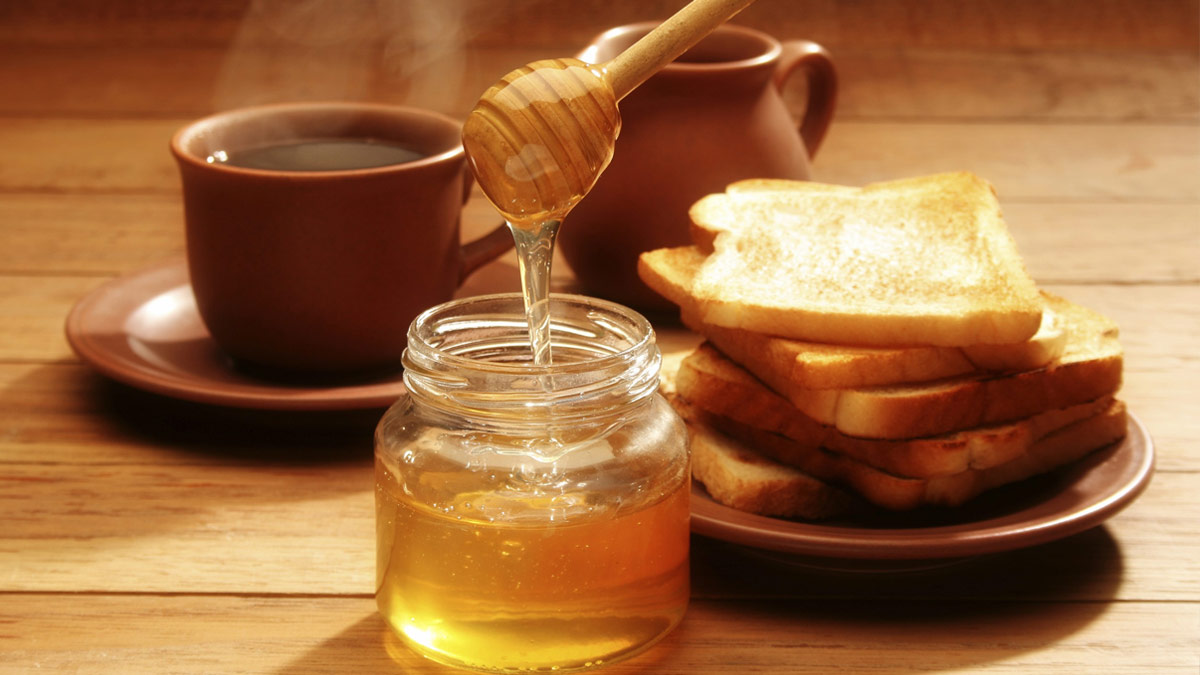
Adapted from Taste of Home